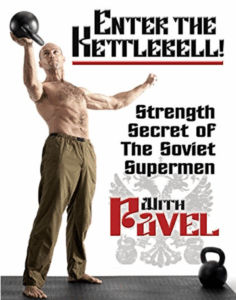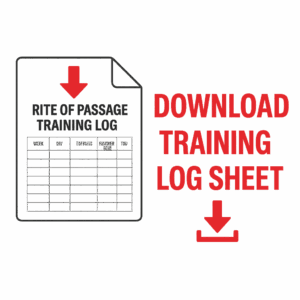Kettlebell – Rite of Passage Program

SYNOPSIS: How to Perform the “Rite of Passage” Program
Schedule: Train three non-consecutive days per week: one Heavy Day, one Medium Day, and one Light Day.
Core Movements:
- Clean & Press
- Pull-Up
- Swing (or Snatch)
- (Optional: Turkish Get Up)
Ladder Format:
- Perform one rep per side (left, then right), then two reps per side, and so on up to your top rung.
- Each complete sequence (e.g., 1-2-3 on both arms) is one ladder.
- Match pull-up reps to the current rung (1 pull-up after 1 press, 2 pull-ups after 2 presses, etc.).No rest between sides; rest 1–3 minutes between ladders.
Ladder Progression:
- Start with 3 ladders of 1-2-3.
- Build up by first increasing the number of ladders: 4 ladders of 1-2-3, then 5 ladders of 1-2-3.
- Once 5 ladders of 1-2-3 are solid, increase the top rung gradually:
- Begin by adding the higher rung to just the first ladder (e.g., 1x 1-2-3-4, 4x 1-2-3).
- Each workout, add the higher rung to one more ladder.
- Progress until all 5 ladders are 1-2-3-4.
- Repeat the same approach to reach 5 ladders of 1-2-3-4-5.
When you complete 5 ladders of 1-2-3-4-5 with consistent quality and recovery, move up to the next heavier kettlebell and restart the cycle at 3 ladders of 1-2-3.
Weekly Structure:
- Heavy Day: Press ladders to your current top rung (e.g., 1-2-3-4).
- Medium Day: Reduce top rung by one step (e.g., 1-2-3).
- Light Day: Reduce top rung by two steps (e.g., 1-2).
Match ladder count across the week or adjust volume based on recovery.
Finisher:
- Perform 100 swings with your Clean & Press kettlebell.
- Swings can be two-hand, one-hand, or hand-to-hand variations.
- Recommended structure: EMOM (Every Minute on the Minute, or an “I-go-U-go” drill).
- Choose a number of reps per minute that feels intense but sustainable.
Ready for the Next Kettlebell?:
Once you complete 5 ladders of 1-2-3-4-5 with consistent form and recovery, test your press with the next heavier bell. (I recommend +4 kg increase)
If successful, restart the cycle with the new weight beginning at 3 ladders of 1-2-3.
Note: if you don’t have access to a pull up bar you can substitute the pull ups with a single one-arm kettlebell row, with the same bell and match the reps of the ladder rung that you are on.
If you do have a pull up bar but are not strong enough yet for full, unassisted pull ups, you can use a resistance band.
Click Here to Download A Printable ROP Training Log Sheet

The Rite of Passage: A Proven Kettlebell Program For All Round Conditioning
The Rite of Passage (ROP), outlined in Pavel Tsatsouline’s Enter the Kettlebell, is a structured and minimalist training plan built around the clean and press, the kettlebell swing, and the pull-up. It’s designed to develop pressing strength, total-body conditioning, and overall athleticism using a single kettlebell.
Why It Works
Key Benefits:
- Simplicity – Minimalist structure. You focus on high-value movements with clear benchmarks.
- Progressive Overload – Built-in ladder system allows structured volume increases without burnout.
- Strength & Stability – The strict press trains full-body tension, shoulder integrity, and spinal alignment.
- Athletic Conditioning – Swings or snatches provide a dose of power, grip, and cardiovascular conditioning.
- Pull-Up Integration – Adds vertical pulling, balances the press, and reinforces total-body control.
- Discipline & Consistency – The light/medium/heavy rhythm teaches control, pacing, and patience.
- Autoregulation – Volume is scaled by ladders and daily intensity, reducing overtraining risk.
What are “Ladders?”
Ladders are an efficient and scalable way to build volume, reinforce technique, and manage fatigue.
- Volume Without Burnout – By interspersing low-rep sets (1, 2) with higher-rep efforts (3, 4, 5), you accumulate meaningful volume without the same fatigue as doing straight sets.
- Built-In Recovery – Lower reps at the beginning of each ladder act as active recovery, letting you maintain high-quality movement throughout the session.
- Progressive Framework – Ladders allow you to progress naturally by adding ladders or rungs. Each increase is measurable and manageable.
- Neurological Efficiency – Repeating perfect reps under increasing demand helps lock in proper mechanics, grip timing, breathing, and body tension.
- Mental Engagement – The stepwise structure keeps you focused and mentally involved in your training rather than zoning out through fixed sets and reps.
